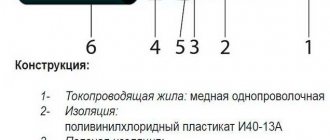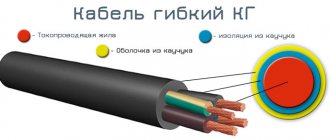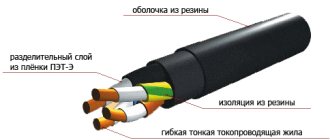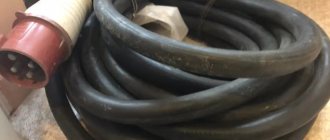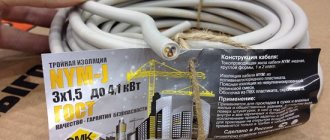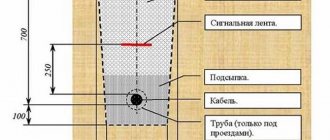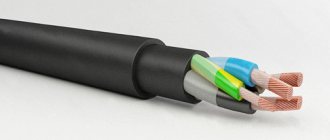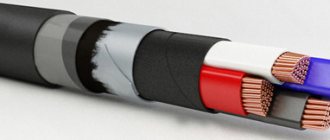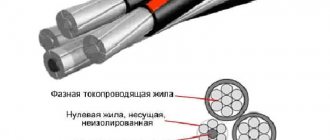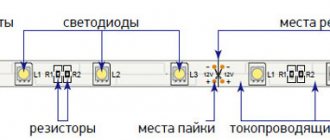The KVVG cable belongs to the group of control cables used in industry when connecting various machines, devices, control devices and other automated equipment.
The main functional difference between control cables is the scope of application. They are made using a technology similar to that used for conventional power wires, but at the same time they have thinner insulation, the breakdown resistance of which is significantly lower than that of power wires. Control cables, and KVVG in particular, are intended exclusively for transmitting a control signal to various machines and devices. We can say that they occupy an intermediate position between power cables and communication cables - telephone, network and other telecommunications.
Please note: unlike telecommunications, control cables, including the KVVG cable, are not low-current. KVVG, in particular, can withstand an alternating current voltage of 660 V, and a direct current voltage of 1000 V.
Definition and differences
First, one persistent myth or controversy must be addressed initially. Many less experienced and qualified “specialists” often confuse it with a VVG type cable, considering them to be the same type or modified. Partly, similar production technology and the structure of the cores contribute to this misconception, but in fact these are completely different products in terms of purpose (scope of application).
In the first case, there is a common VVG cable, which belongs to the power group, that is, those that are used for direct transmission of electricity. Due to such conductors, voltage is supplied to the key power and actuating mechanisms of the equipment.
The second cable is not at all a modernization of the previous one, but a full-fledged self-sufficient product that belongs to the control category. Its main difference from power is that the transmitted low-voltage voltage is used not to ensure the operation of components and mechanisms, but to control it. It is used for connection with ballasts, automation, relay protection devices, etc.
In addition, there are a number of design differences:
- Color marking of current-carrying conductors. Control cables KVVGng or KVVGEng have twisted cores. Each twist necessarily contains a counting and guide wire, the insulation of which is blue and red, respectively. The power cable, on the contrary, consists of individual elements with insulation of different colors,
- Thickness of the insulating layer. According to regulatory documents, control cables KVVGng, KVVGEng and others have insulation of a thinner thickness than their analogue cross-section of the power type. For example, for a 2.5 mm2 core, this figure is 0.7 mm and 0.8 mm, respectively,
- Heating temperature. The maximum threshold for power cables is 80ºС, while for the control cables KVVGng and KVVGEng it is lower - 70ºС,
- Elasticity. This parameter is responsible for the ability to bend during installation. For a power cable, the minimum radius is about 10 outer diameters, and for KVVGng or KVVGEng - at least 4.
Scope of application
This cable is intended for connecting control systems, control circuits, relay protection and other types of automated control and monitoring of various equipment. In this case, it is necessary to ensure that the connection does not move.
Laying can be done in any way - closed, open, including in an aggressive environment (for example, in soil with high acidity or salinity), by drawing in the open air, if sagging is not allowed. KVVG is afraid of stretching, as well as mechanical damage, therefore, in the case of open installation, it must be reliably protected from any kind of force.
Marking of cable products
Those designations that are incomprehensible at first glance, which have already been mentioned above, have a clear basis, since they determine the technical characteristics of individual products and the scope of their possible application. The decoding of the abbreviations KVVGng, KVVGEng is as follows:
- K - indicates that this is a control cable,
- B (first) - means that the conductors have polyvinyl chloride (PVC) insulation,
- B (second) – a PVC shell is used,
- G – lack of protective cover,
- E – the presence of a shielded ball made of aluminum foil,
- NG – outer shell made of plastic compound that does not support combustion.
It should also be taken into account that since the designation does not have the letter A (aluminum) at the beginning, the conductors are copper.
Explanation of the name
Here, according to the old Russian tradition, everything is simple. KVVG means "control - vinyl - vinyl - bare." The first letter in the index indicates the purpose, the second and third - the material of insulation of the conductors and outer shell (in this case, vinyl, more precisely, polyvinyl chloride plastic), the fourth - “G” - means “bare”, that is, without armor - steel braid.
There is also a control cable of the KVVGE brand, the fifth letter in the index of which means “Screen”. It says that the conductors are shielded from the effects of external electric fields by a special layer between the individual insulation of the conductors and the general protective sheath.
There are also KVVGng and KVVGng-ls - non-flammable cables designed for special conditions.
Design features, characteristics of KVVGng
This type of product is used to transmit alternating current with voltages up to 660 V and 100 Hz, as well as direct current - up to 1000 V. As follows from the decoding, copper conductors are used here. They can be combined into several concentric strands (one on top of the other), with the obligatory presence in each of them of a countable pair of cores (red and blue insulation). Their number can vary depending on the need, cross-section (0.75...10 mm2), and ranges from 4 to 37 pieces. Accordingly, the outer diameter of the wire can range from 7.6 mm (for a 4 × 0.75 cable) to 25.3 mm (for 10 × 10). The last pair of letters of the KVVGng marking means that the outer layer has a reduced degree of flammability. That is, it can be used with increased fire safety requirements.
The bending radius of cables with an outer diameter of up to 10 mm is at least 3D, and for larger ones - 4D.
Cables of the KVVGng type are used to organize fixed connections in an open manner. Laying in a trench is also allowed, but it should be taken into account that the cable is not armored.
Characteristics of BCP
The PPG cable includes one or more conductive cores of the first and second class. It contains a PVC insulating layer covering each core, with an inner PVC sheath that provides cable protection. It contains the outer shell of insulation.
The cable is made of polymer protection, but it does not contain halogen, which, when burned, releases substances that are toxic to humans. As a result, less gas and smoke is produced during smoldering. GPG is widespread in nuclear power plants, thermal power plants, the petrochemical industry, on ships and in public buildings. You can meet him at a train station, gym or airport. Sometimes used in commercial, residential buildings.
The conductor has a long service life. He has been online for at least 30 years. The cable does not support combustion in case of fire if used in a single or group electrical installation. Its operating voltage is 1000 watts. The conductor contains from one to five cores with a total cross-section of 1.5 to 240 square millimeters.
The PPG cable is resistant to dampness, ultraviolet rays and mold. Its maximum heating temperature during operation is 700 degrees. Recommended installation conditions are temperatures up to -150 degrees.
The cable can be deciphered simply:
- P - polymer type of insulation without halogen;
- P - polymer shell type without halogen;
- G - bare cable, devoid of a protective sheath by design.
Cables with the abbreviation PPGng-A-Hf are often sold on the market. The last three letters indicate the absence of combustion support, the absence of halogen in the insulated shell. The letter A denotes the aluminum core material. The numbers in the abbreviation indicate the number of cores with a cross-sectional diameter.
Design features, characteristics of KVVGEng
This type of product has the same voltage specifications as the previous one. The main condition for its use is increased fire safety requirements, non-propagation of flame when using a group method of laying cables. The conditions for laying KVVGEng are similar - openly, in boxes or tunnels.
Structurally, KVVGEng consists of the following key components:
- Single-wire copper conductors,
- PVC core insulation,
- PVC insulation (wrap, belt) twists,
- Screen (aluminum foil). In decoding it is designated as E,
- External protective layer made of PVC. As a rule, a hose based on NGP plastic compound, etc., is used.
Unlike KVVGng, cable type KVVGEng has a larger minimum bending radius, equal to approximately 6D. The number of cores can similarly range from 4 to 37 pieces. At the same time, the maximum cross-section of one core is only 6 mm2.
Cables of the KVVGng and KVVGEng types are widely used to organize control lines responsible for organizing testing of the serviceability and accuracy of the main equipment. Their specialty is low-voltage lines, and the insulation is thinner, which reduces the overall cost in comparison with power analogues. It is not armored and therefore installation instructions must be observed.
The difference between VVG cable and other brands
NYM difference from VVGng
“NYM” cable - as a rule, preference is given to using such a cable for hidden wiring in an apartment, since it is easier to install in prepared grooves than VVG (VVng). It is immune to flooding, as it has an additional insulating layer of rubber. Relevant for laying wiring in bathrooms and other rooms with high humidity.
For installation of wiring in open areas, it is better to use VVGng wire, as it is more resistant to ultraviolet radiation. In case of fire in residential and other premises where there is a real threat to the life and health of people, it is better to use the VVGng-ls cable rather than NUM, since it practically does not emit toxic smoke.
An important role when choosing a cable is played by the issue of price. NUM is about 15% more expensive than VVGng.
Cable PVS and VVG
PVA is a stranded copper wire that is characterized by very good flexibility. However, the permissible voltage of the PVA is much lower than that of the VVG cable. The service life of the VVG cable exceeds the service life of the PVS by approximately 3 times. When installing PVA, it is necessary to tin, which can easily be considered one of the main disadvantages of PVA.
Therefore, for the installation of hidden electrical wiring, which is laid for a large amount of time, a VVG cable with non-combustible insulation is more often used.
PVA or SHVVP are more often used in the domestic sphere, for example, in the production of extension cords.
Manufacturing companies
In specialized stores, the assortment of KVVG is so large that a novice specialist can easily get confused when choosing the right wire.
Therefore, we have compiled a list of reliable manufacturers who have proven themselves to be the best in this segment.
- Voronezh "TD RT-Cable".
- OJSC Rybinsk Cable Plant.
- CJSC "Agrokabel"
- JSC "Belarusian Cable Plant".
- OJSC Verkhneoksky Cable Plant.
- JSC "Voronezh TV Cable Plant"
- CJSC "Caucasian Cable Plant"
- OJSC "Podolsk Cable Plant"
- OJSC "Pskov Cable Plant"
- JSC Tomsk Cable Plant.
- Cable Alliance Holding LLC, a subsidiary joint stock company of SIBKAKABEL.
- LLC "GK" "SEVKAKABEL", St. Petersburg.
There are also a number of similar cables that can replace KVVG: 1 – NYY, NYM(St), NYM-J, NUM-O.
As can be seen from this article, control cables are quite functional and reliable. Therefore, we hope that a detailed description of the characteristics of KVVG, as well as recommendations on manufacturing companies, will help you make the right choice.
Various indications for these cables
According to clause 4.1 e)-g) GOST 31996-2012 decoding for these cables VVG, VVGng(A) and VVGng(A)-LS:
f) on performance in terms of fire danger indicators:
- flame retardant when installed alone (no designation);
- flame retardant during group installation (ng): according to category A - ng(A),
- flame retardant when installed in groups, with reduced smoke and gas emissions (ng-LS);
g) according to the cross-sectional shape of the cable:
- round (no designation);
- flat (P).
In accordance with clause 6.3.2, cables of versions “ng” and “ng-LS” should not spread fire when laid in groups. Test category A is established in the technical specifications for cables of specific brands.
According to clause 6.3.3, cables of “NG-LS” versions must have low smoke and gas emissions during combustion and smoldering.
Using KVVG
From the very name “control cable” or “control cable” it is not difficult to guess that this type of wire was originally intended for use in electrical circuits for monitoring or control.
In addition, as can be seen from the wide range of wires, there are many “not low-current” ones, thanks to which KVVG can be used to control contactors with high load and power, as well as to collect readings from limit switch sensors.
Also, the capabilities of the wire allow it to cope with the load of electric motors and other executive action motors. However, we recommend connecting them via power wires.
Choose a GOST or TU cable?
In a separate article, we looked at the differences between GOST and TU cables. In short, any cable is manufactured according to the technical specifications of the plant (abbreviated as TU). This means that the manufacturer declares certain conditions that the cable meets (resistance per 1 km of cable, sheath and insulation materials, filler, type of metal, etc.). At the same time, each plant has the opportunity to obtain compliance of its plant’s specifications with the state standard (abbreviated GOST).
If a plant receives GOST for its products, this means that the cable production plant’s specifications comply with the GOST standard. In common people, the cable that does not pass certification is called TU (because the cable complies with the Technical Conditions of the plant, but does not comply with GOST), and the cable that has passed certification is called GOST (that is, the plant’s specifications comply with GOST).
Very often we are asked the question - what to take, GOST or TU? This decision remains primarily yours. We, for our part, believe that the optimal cable in terms of quality-price ratio is the VVGng GOST cable - that is, a flat cable without filler, but made in accordance with GOST. It is more than enough for household needs.
Sources
- https://220.guru/electroprovodka/provoda-kabeli/kabel-nym.html
- https://buildingclub.ru/kabel-vvgng-3h25-i-3h15-treb-gost/
- https://chistayrabota.ru/kabel-nym-ili-num-raznica/
- https://domikelectrica.ru/luchshij-kabel-dlya-provodki-v-kvartire-nym-i-vvgng-ls-otlichiya-xarakteristiki/
- https://www.vseinstrumenti.ru/electrika-i-svet/kabel-i-provod/articles/tipy-kabelej/
- https://vchemraznica.ru/chem-otlichaetsya-kabel-vvgng-ot-vvgng-ls-opisanie-i-otlichiya/
- https://electric-220.ru/nym-ili-vvgng
[collapse]
